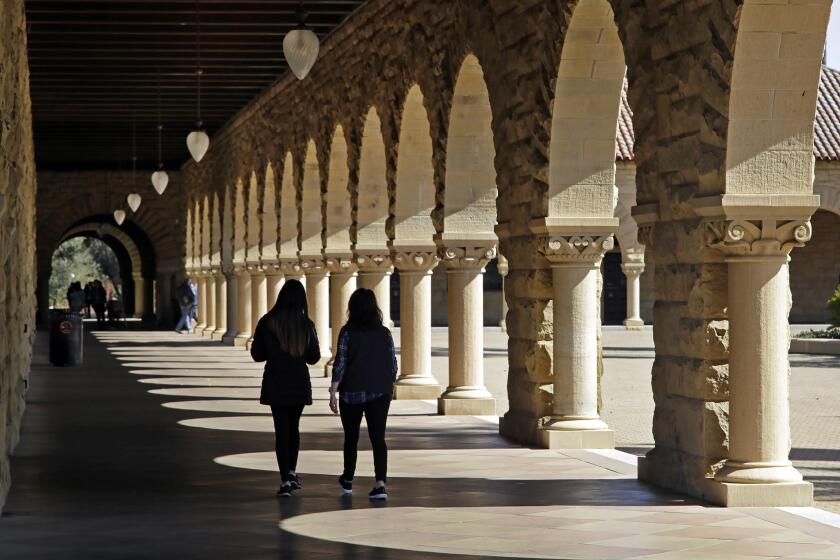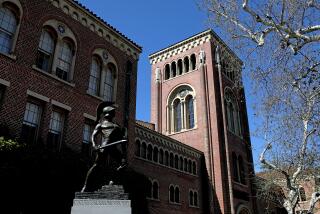
- Share via
Amid the Trump administration’s assault on higher education and academic freedom — shaking down institutions like Columbia, targeting pro-Palestinian scholars and students for deportation and dispatching chilling letters meant to silence dissent — last week brought an unexpected but welcome development: The University of California announced its campuses will no longer be able to require diversity statements in hiring.
It’s an important win for the principle that universities should be engines of inquiry, not theaters for ideological performance.
Diversity statements first emerged in the 2000s and 2010s, gaining traction within the UC system before spreading across elite academia nationwide. They were animated by a noble and urgent purpose: remedying decades of invidious discrimination in hiring and working to create academic communities made up of scholars with widely varied backgrounds. But rather than fostering diversity in a broad, humanistic sense, the statements morphed into ideological litmus tests — bureaucratic hurdles cloaked in the rhetoric of inclusion.
The decision ends a UC practice requiring job applicants to submit written testimonials about how they have worked to enhance diversity.
Various departments at UC’s 10 campuses, for example, prescriptively defined “diversity,” “equity” and “inclusion” in official documents, then judged applicants according to their adherence. Many positions used diversity statements as an initial screen: Fail to repeat the right orthodoxies on an array of controversial issues, and your candidacy was dead on arrival.
The message was unmistakable. To be a qualified scholar, you must first prove yourself to be a loyal disciple.
A cottage industry soon emerged to coach applicants through the incantation. UC Merced sociologist Tanya Golash-Boza, for example, advised candidates in an Inside Higher Ed article to “concentrate on issues such as race, gender, social class and sexual orientation” in their statements, writing “about racial oppression, sexism, homophobia, transphobia, ableism or some other commonly recognized form of oppression.”
Now the left is making a lot of the same critiques, noting that this time the dystopian directive comes from the top of the federal government.
Successful applicants learned to elevate this voguish and normative understanding of diversity. Talk about racial oppression; don’t talk about the classical liberal understanding of individualism. Rubrics used by UC campuses downgraded candidates whose philosophical beliefs motivated them to focus on different topics, including that diversity means “treating everyone the same.” Some prospective applicants chose not to apply to UC professorships they would otherwise be qualified for, knowing their views — or, more precisely, their refusal to renounce those views during the hiring process — guaranteed rejection.
Adhering to a diversity script is no way to foster inclusion — it is an intellectual narrowing that conflicts with the 1st Amendment traditions that define American academia. As Justice William J. Brennan wrote in Keyishian vs. Board of Regents (1967), “Our Nation is deeply committed to safeguarding academic freedom ... [which] does not tolerate laws that cast a pall of orthodoxy over the classroom.”
President Trump’s illegal actions against Columbia University and disfavored law firms must be fought. Otherwise, like all bullies, the president will only be emboldened.
The same must be said of institutional policies that, under the banner of inclusion, enforce a conformity of “commonly recognized” beliefs.
Importantly, “diversity” as practiced in these statements is not a metonym for “diversity” that respects students and embraces difference. The former privileges ideological fluency over substantive contribution. Rather than build a supportive academic community, it responds to a diktat to recite shibboleths.
Diversity that is genuine, and that endures, cannot be routinized by fiat. It comes from the robust exchange of ideas, where faculty and students feel free to discuss controversial issues without fear of retaliation.
The Trump administration’s relentless war on higher education is rightly judged as evoking the McCarthyist purges of the mid-20th century. But diversity statements, ironically, also echo that ethos. They are just another form of loyalty oath. Instead of demanding disavowal of the Communist Party, they ask faculty candidates to affirm a progressive creed. The form and context are different, but the impulse is the same.
Unsurprisingly, diversity statements have become an easy caricature for the Trumpist right — a totem of leftist overreach that fuels the right’s destructive efforts to dismantle the modern university.
I teach college students, and I’m grateful when they make me think hard about transformation and identity, nature and convention, character and performance.
Universities have a legitimate interest in reducing the risk of government and cultural reprisals that could harm their core teaching and research functions, especially in this perilous and politically combustible climate. The University of California’s decision to ban required diversity statements did just that — ending a potent symbol of leftist excess in the face of President Trump’s catastrophic threats and intrusions into academic autonomy.
The answer to the right’s authoritarian offenses cannot be authoritarian offenses from the left. The antidote is a return to first principles: rigorous research, a pluralism of ideas and a respect for disciplinary expertise. Saving American higher education from the existential dangers posed by Trump may not be possible, but returning to the basics gives us a fighting chance.
Duncan Hosie is a constitutional law fellow at the Brennan Center for Justice at New York University School of Law. He has litigated 1st Amendment cases, including as an appellate attorney and as a fellow with the ACLU.
More to Read
Insights
L.A. Times Insights delivers AI-generated analysis on Voices content to offer all points of view. Insights does not appear on any news articles.
Viewpoint
Perspectives
The following AI-generated content is powered by Perplexity. The Los Angeles Times editorial staff does not create or edit the content.
Ideas expressed in the piece
- The article argues that eliminating mandatory diversity statements protects academic freedom by removing ideological litmus tests that pressured applicants to endorse specific views on race, gender, and social justice. Critics of these statements likened them to political loyalty oaths, which they claim stifled intellectual diversity by privileging progressive orthodoxy over scholarly merit[1][8].
- According to the author, diversity statements evolved from their original purpose of fostering inclusivity into bureaucratic hurdles that enforced conformity. UC campuses prescriptively defined terms like “equity” and used rubrics that penalized candidates who emphasized treating individuals equally rather than prioritizing identity-based frameworks[5][8].
- The decision to end mandatory statements is framed as a defense of First Amendment principles, avoiding compelled speech while still allowing faculty to discuss inclusive achievements in teaching, research, or service. This shift aligns with concerns that DEI policies risked mirroring McCarthy-era tactics by demanding allegiance to a prescribed creed[7][9].
Different views on the topic
- Some UC faculty and diversity advocates argue the policy change capitulates to political pressure from the Trump administration, which threatened federal funding cuts for DEI programs. Brian Soucek, a UC Davis law professor, called the move a “preemptive appeasement” that undermines efforts to address systemic inequities in academia[1][2][4].
- Opponents emphasize that diversity statements were designed to ensure faculty could address the needs of underrepresented communities through scholarship and mentorship. UC’s own research suggested these statements helped identify candidates committed to combating discrimination, particularly in fields historically exclusionary to marginalized groups[1][6][7].
- While mandatory statements are eliminated, UC retains policies allowing faculty to highlight inclusive work in other application materials. Critics warn this could dilute accountability, as optional references to diversity may not receive the same scrutiny, potentially weakening progress toward equitable representation[3][4][5].
A cure for the common opinion
Get thought-provoking perspectives with our weekly newsletter.
You may occasionally receive promotional content from the Los Angeles Times.













